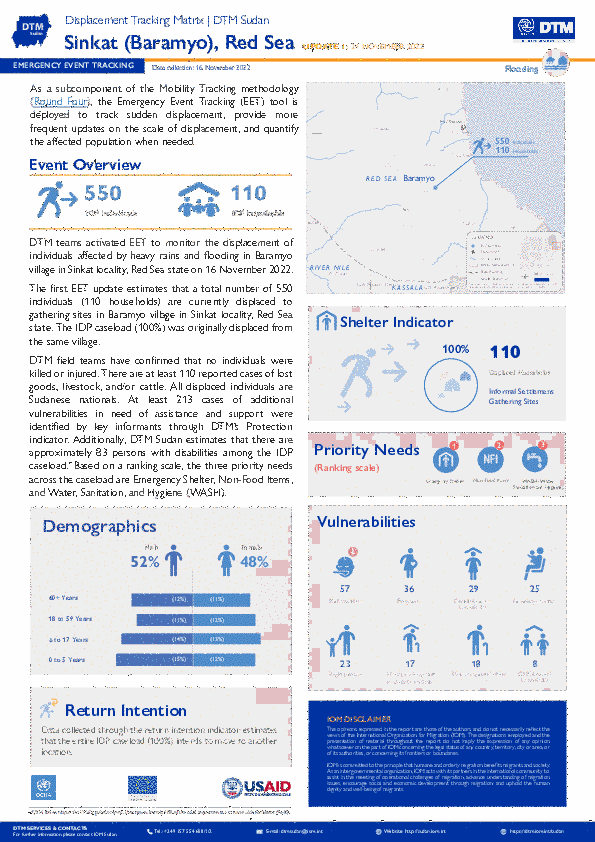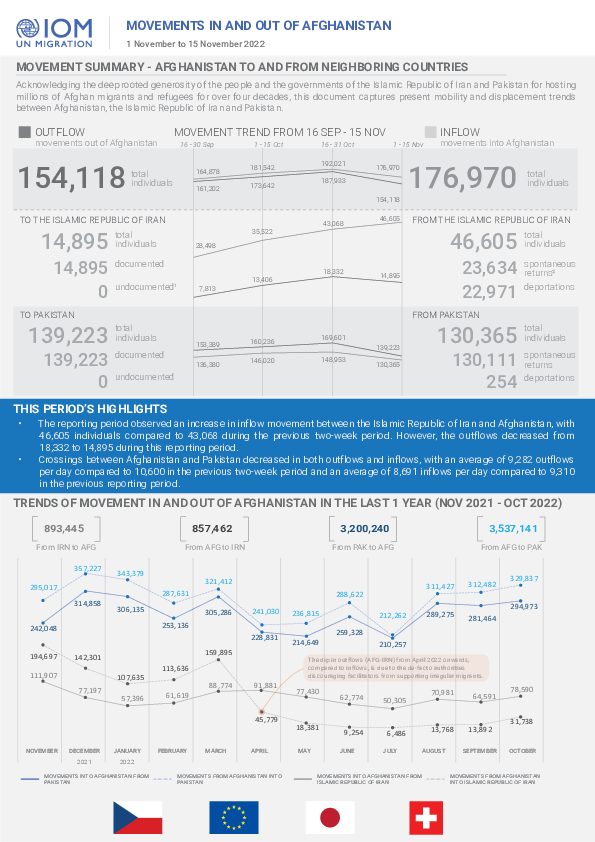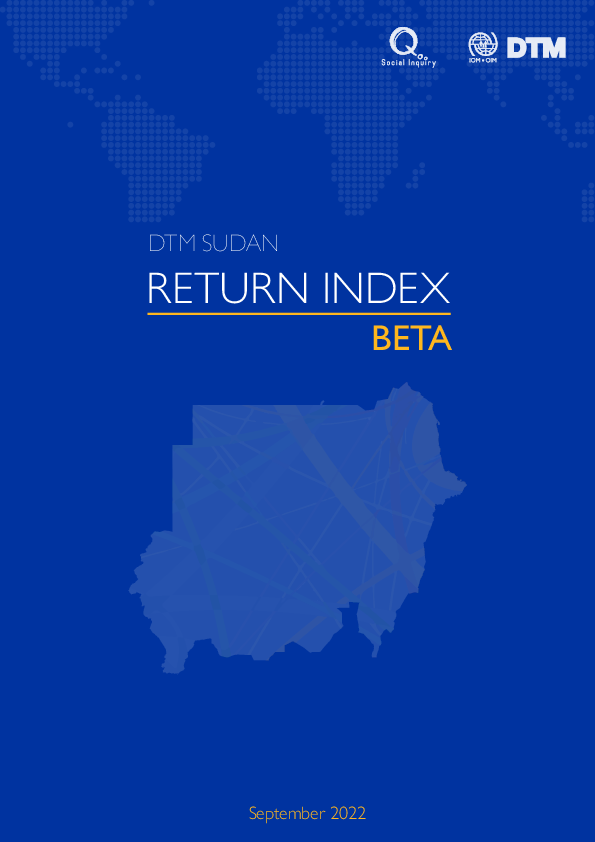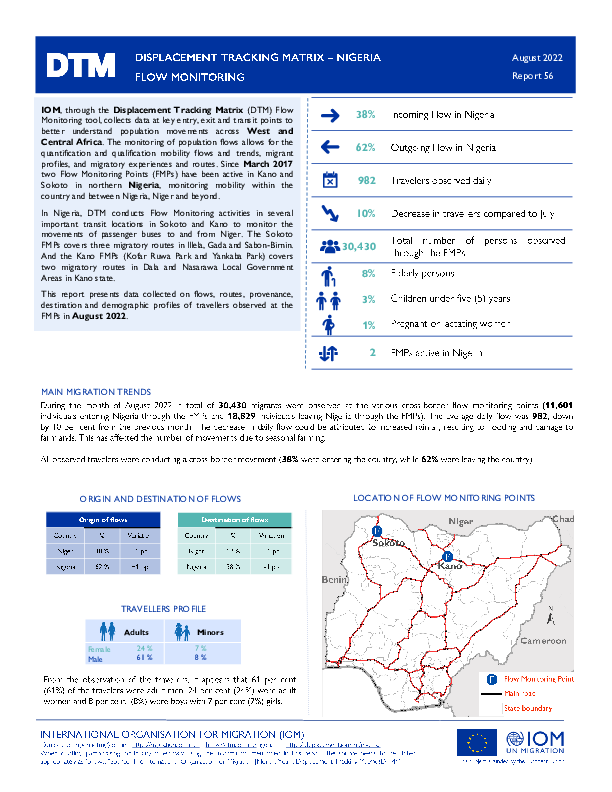-
Countries
-
Data and Analysis
-
Special Focus
-
Crisis Responses
Contact
DTMMadagascar@iom.int
Location
Madagascar
Activity
- Mobility Tracking
- Baseline Assessment
Period Covered
Sep 01 2022 -Sep 30 2022
A baseline assessment is a sub-component of mobility tracking. It aims to collect data on IDP, migrant or returnee population presence in a defined administrative area of the country.
Population Groups
Survey Methodology
Unit of Analysis Or Observation
Type of Survey or Assessment
Keywords
Geographical Scope
Administrative boundaries with available data
The current dataset covers the following administrative boundaries
Nov 24 2022
Print
The Grand Sud of Madagascar has been affected by consecutive droughts during the rainy seasons from 2019 to 2021. In 2021, 36% of the Grand Sud was classified as severe drought and 1% as extreme drought. Nearly 1.47 million people were severely food insecure (IPC 3+) and four districts – Amboasary Atsimo, Ambovombe Androy, Tsihombe and Ampanihy West – were in IPC Phase 4 (Emergency).
Countries in this response
- Active DTM operation
- Past DTM operation

Contact
DTM Sudan; dtmsudan@iom.int
Language
English
Location
Sudan
Snapshot Date
Nov 16 2022
Activity
- Mobility Tracking
- Event Tracking
The DTM Emergency Event Tracking (EET) is deployed to track sudden displacement and population movements, provide more frequent updates on the scale of displacement, and quantify the affected population when needed. As a subcomponent of the new Mobility Tracking methodology in Sudan (Round Four), and activated on a need basis, EET utilises a broad network of key informants to capture best estimates of the affected population presence per location – a useful tool for humanitarian response planning and design.

Contact
DTM Madagascar, DTMMadagascar@iom.int
Language
English
Location
Madagascar
Period Covered
Sep 01 2022
Sep 30 2022
Activity
- Mobility Tracking
- Baseline Assessment
The Grand Sud of Madagascar has been affected by consecutive droughts during the rainy seasons from 2019 to 2021. In 2021, 36% of the Grand Sud was classified as severe drought and 1% as extreme drought. Nearly 1.47 million people were severely food insecure (IPC 3+) and four districts – Amboasary Atsimo, Ambovombe Androy, Tsihombe and Ampanihy West – were in IPC Phase 4 (Emergency).
The results presented below are the result of evaluations conducted in September 2022 in 20 municipalities: Ambovombe (Ambanisarika, Maroalomainty, Maroalipoty, Marovato Befeno, Sihanamaro), Tsihombe (Anjapaly, Ankilivalo, Betanty, Imongy, Tsihombe, Amboasary Atsimo (Amboasary Atsimo, Behara, Ebelo, Ifotaka, Sampoana), Ampanihy Andrefana (Amboropotsy, Ampanihy Andrefana, Androka, Ankiliabo, Beahitse).

Contact
DTM Madagascar, DTMMadagascar@iom.int
Language
English
Location
Madagascar
Period Covered
Sep 01 2022
Sep 30 2022
Activity
- Mobility Tracking
- Baseline Assessment
Le Grand Sud de Madagascar est affecté par des sécheresses consécutives au cours des saisons des pluies de 2019 à 2021. En 2021, 36% du Grand Sud est classé en sécheresse sévère et 1% en sécheresse extrême. Près de 1,47 millions de personnes sont en situation d'insécurité alimentaire sévère (IPC 3+) et quatre districts - Amboasary Atsimo, Ambovombe Androy, Tsihombe et Ampanihy Ouest - sont en Phase 4 de l'IPC (Urgence).
Les résultats présentés ci-dessous sont le fruit des évaluations menées en septembre 2022 dans 20 communes: Ambovombe (Ambanisarika, Maroalomainty, Maroalipoty, Marovato Befeno, Sihanamaro), Tsihombe (Anjapaly, Ankilivalo, Betanty, Imongy, Tsihombe, Amboasary Atsimo (Amboasary Atsimo, Behara, Ebelo, Ifotaka, Sampoana), Ampanihy Andrefana (Amboropotsy, Ampanihy Andrefana, Androka, Ankiliabo, Beahitse).

Contact
DTMAfghanistan@iom.int
Language
English
Location
Afghanistan
Period Covered
Nov 01 2022
Nov 15 2022
Activity
- Flow Monitoring
The snapshot captures present mobility and displacement trends between Afghanistan, the Islamic Republic of Iran and Pakistan.

Contact
dtmsudan@iom.int
Language
English
Location
Sudan
Period Covered
Dec 15 2021
Jan 16 2022
Activity
- Return Intention
- Mobility Tracking
To address a gap in information on the conditions in which permanent returnees are living across Sudan, which makes difficult to understand why IDPs return to some areas and not others or, put another way, what makes some locations more conducive to voluntary return than others, IOM DTM designed the first ever (beta version) Return Index for Sudan.
Sudan Return Index Beta evaluates the material and social living conditions in locations of return in Sudan based on a common and comparable value. This tool shows that locations with better conditions are also more conducive to having returnee populations. The Return Index can be used to infer what conditions are most critical for facilitating returns, how to address obstacles, where to geographically target interventions and advocacy, how to strategize for resources and operations, and to explore changes in conditions over time.
The tool provides a means of measuring the severity of living conditions in locations of returns by combining first, a collection of context informed minimum or critical living conditions that are necessary to make a location adequate enough to sustain returning populations; and second, quantitative analysis to generate and apply an index score to each location based on the state of these indicators.

Contact
DTM Nigeria, AllUsersInDTMNigeria@iom.int
Language
English
Location
Nigeria
Period Covered
Aug 01 2022
Aug 31 2022
Activity
- Flow Monitoring
In Nigeria, DTM conducts Flow Monitoring activities in several important transit locations in Sokoto and Kano to monitor the movements of passenger buses to and from Niger. The Sokoto FMPs covers three migratory routes in Illela, Gada and Sabon-Birnin. And the Kano FMPs (Kofar Ruwa Park and Yankaba Park) covers two migratory routes in Dala and Nasarawa Local Government Areas in Kano state. This report presents data collected on flows, routes, provenance, destination and demographic profiles of travellers observed at the FMPs in August 2022.
During the month of August 2022, a total of 30,430 migrants were observed at the various cross-border flow monitoring points (11,601 individuals entering Nigeria through the FMPs and 18,829 individuals leaving Nigeria through the FMPs). The average daily flow was 982, down by 10 per cent from the previous month. The decrease in daily flow could be attributed to increased rainfall, resulting to flooding and damage to farmlands. This has affected the number of movements due to seasonal farming. All observed travelers were conducting a cross-border movement (38% were entering the country, while 62% were leaving the country).

Contact
DTM Mali, DTMMali@iom.int
Language
English
Location
Mali
Period Covered
Oct 01 2022
Oct 31 2022
Activity
- Flow Monitoring
In order to gain a better understanding of mobility flows and trends, the International Organization for Migration (IOM) has implemented the Displacement Tracking Matrix’s Flow Monitoring (FM) tool at key transit points across the region. Flow Monitoring activities are conducted in close cooperation with national and local authorities as well as local partners. The Flow Monitoring tool consists of two main components: the Flow Monitoring Registry (FMR), which captures key data on the volume, origin, destination and mode of travel of mobility flows, and the Flow Monitoring Survey (FMS), individual surveys conducted with travellers to gather detailed information about the profiles, migration experience and intentions of migrants. Through these activities, the Flow Monitoring tool collects data on migration flows and trends, traveller profiles, migration journeys, and intentions of migrants, so as to obtain a better understanding of mobility.
In Mali, DTM conducts Flow Monitoring activities at seven Flow Monitoring Points (FMPs) located across six regions, in order to foster a better understanding of the numbers, trends, profiles, and journeys of migration flows crossing these points.
This reports presents data collected through the Flow Monitoring Registry in October 2022.

Contact
DTM Mali, DTMMali@iom.int
Language
French
Location
Mali
Period Covered
Oct 01 2022
Oct 30 2022
Activity
- Flow Monitoring
Afin de mieux comprendre les mouvements et tendances migratoires, l’OIM, à travers la Matrice de suivi des déplacements (Displacement Tracking Matrix, DTM), met en œuvre l’activité de Suivi des flux de populations (Flow Monitoring, FM).
Le suivi des flux, qui est mis en œuvre en étroite collaboration avec les autorités et des partenaires nationaux et locaux, est composé de deux outils: l’enregistrement des flux (Flow Monitoring Registry, FMR), qui recueille des données clés sur l’ampleur, la provenance, la destination et les modalités des flux de mobilité, et les enquêtes individuelles (Flow Monitoring Survey, FMS), conduites auprès des voyageurs afin d’obtenir des informations sur les profils, parcours migratoires, et intentions des migrants. Le suivi des flux de populations récolte ainsi des données sur les flux et tendances migratoires, les profils des voyageurs et les parcours et intentions des migrants, afin de fournir une meilleure compréhension des mobilités.
Au Mali, la DTM recueille des données au niveau de 7 Points de suivi des flux (Flow Monitoring Points, FMP), répartis dans 6 régions afin d’obtenir une meilleure compréhension de l’ampleur, des tendances, des caractéristiques socio-démographiques et des parcours des flux de voyageurs traversant ces différents points.
Ce rapport présente les données recueillies dans le cadre des activités d’enregistrement des flux durant le mois de octobre 2022.
